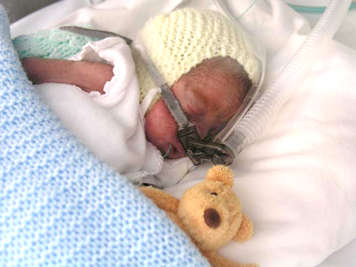Premature babies with lung complications will often require supplemental oxygen. There are several different ways to provide oxygen, each with its own benefits and risks.
Supplemental oxygen
Frequently, premature babies with lung complications of any type will require some form of supplemental oxygen. Although there are several ways to provide oxygen, most of which are described below, the simplest and least invasive method is simply to provide a more oxygen rich environment for the baby. This can be accomplished using a nasal cannula or a “head box,” which is a plexiglass device that rests over the baby’s head, or by increasing the oxygen levels in a closed incubator. Giving oxygen in this way avoids some of the more severe complications that can come from mechanical ventilation. Even so, the baby must be able to breathe on their own and there are some risks.
Although it may seem counterintuitive, the lungs can be injured when exposed to excessive levels of oxygen. Additionally, exposure of the premature baby to oxygen increases the risk for retinopathy of prematurity (ROP). Fluctuation of oxygen levels in the developing retina in the eye is an important factor for the regulation of the growth of blood vessels. If a premature baby has a condition that affects the regular flow of oxygenated blood to or around the eye, the blood vessels of the retina may grow abnormally causing ROP.
For these reasons, levels of oxygen in the baby’s blood and the surrounding environment are monitored continuously.
Mechanical ventilation

Continuous positive airway pressure
Continuous positive airway pressure (CPAP) is the delivery of air and extra oxygen, usually through small tubes placed in the nose, called nasal prongs, or through a mask. Sometimes, though rarely, the oxygen is delivered more directly to the lungs through a longer tube via either the nose or the mouth. This mixture of air and oxygen gas is gently blown through the prongs, creating a slightly higher amount of pressure within the oral cavity and lungs than in the surrounding environment. Although not particularly forceful, this pressure helps prevent the lungs from collapsing and makes breathing easier, since the lungs are constantly filled with a small amount of gas and very little effort is needed for each breath. The amount of oxygen given in the mixture with air can be adjusted to satisfy the oxygen needs of the baby’s body. Additionally, the pressure created in the lungs can also be adjusted. The goal is to keep the lungs inflated without putting too much strain on the lungs themselves. As breathing and lung strength improves, the baby will be weaned off CPAP by slowly reducing the pressure, and/or assessing the baby’s breathing without the assistance of CPAP.

Conventional mechanical ventilation
Under normal circumstances, when someone takes a breath, the lungs expand, pulling air into the lungs. With conventional mechanical ventilation (CMV), the ventilator pushes a measured amount of gas into the lungs at a certain rate meant to mimic normal breathing. The rate, the volume of air (or pressure), and its oxygen content can all be adjusted for the individual baby. The lungs are rather like an elastic band: as the ventilator pushes a measured amount of air into the lungs, they stretch. At the end of the ventilator breath, the lungs stop stretching, then recoil to their resting state.
Modern ventilators can sense when a baby is about to take a breath and synchronize ventilator breaths with the spontaneous breaths of the baby. In this way, CMV can be used to support breathing rather than replace it.
High frequency oscillation
High frequency oscillation (HFO) is another mode of achieving gas exchange without using pushes from a ventilator. It is generally used for babies at risk for developing significant lung disease and damage. HFO puts pressure into the lungs, keeping them open, and then shakes very small volumes of air in and out of the lungs at a high rate. With the lungs always open, tiny volumes of air cycle through the lungs at 600 to 900 shakes, or oscillations, per minute. HFO has the advantage of reducing the strain and stretching on the lung because the lungs are not opening and closing. Although babies can breathe spontaneously on HFO, many get comfortable with it and stop active breathing. To wean a baby off HFO, the tiny volume of air being shaken or oscillated is gradually lowered. As the carbon dioxide levels in the baby’s blood begin to rise as a result, their brain will encourage them to begin taking breaths.
High frequency jet ventilation
High frequency jet ventilation (HFJV) is similar to HFO, except that instead of oscillations to drive oxygen into the lungs, it uses something like the action of a tiny air gun. There is a steady, continuous flow of gas into the lungs that is interrupted very frequently by pulsatile jets of gas directed at right angles to the continuous flow of gas. Jets of gas enter the lung at high rates. In general, HFJV is commonly used for babies that have developed pulmonary interstitial emphysema. In this condition, which can be caused by mechanical ventilation, small air-filled parts of the lung are effectively cut off from the rest of the lung and no longer functional.